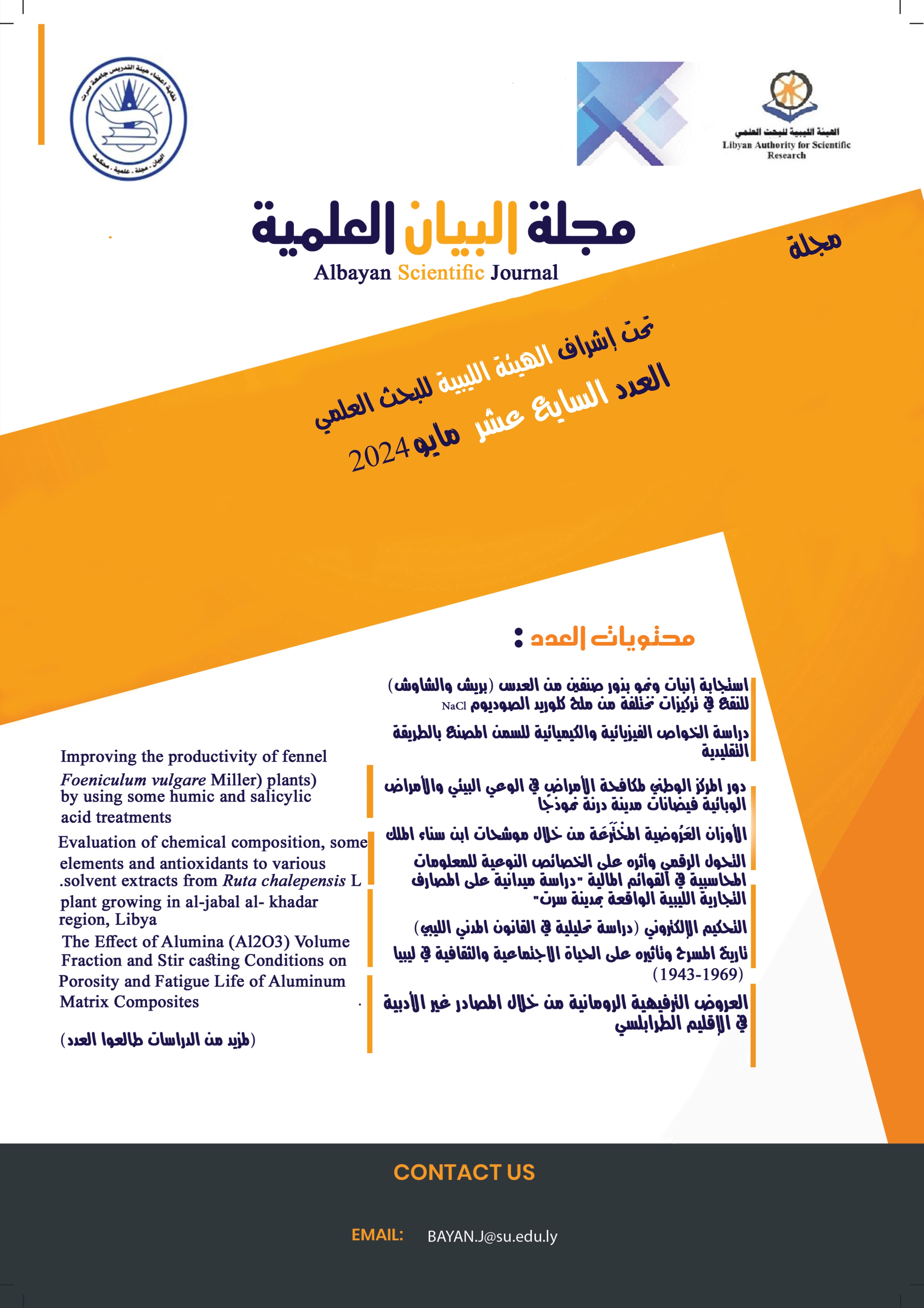An epidemiological study of the Cutaneous leishmaniasis parasite in the northern part (Sirte, Al-Washka, Zamzam, Buqrin) of Libya from 2016 to 2019
Keywords:
Leishmania parasite, Cutaneous leishmaniasis, LibyaAbstract
This study was conducted to determine the extent of the spread of cutaneous leishmaniasis (CL)in the central coastal area of northern Libya specifically (Sirte, Bougrain, Zamzam, and Al-Washka), which is about 450 km to the east of the city of Tripoli. This paper aims to count the number of infections in the specified area during the period extending from 1 January 2016 to 31 march 2019. The number of cases of CL was 156 recorded in all the area, and as the highest Infection rate (3.2%) was observed in the age group (21-39yr) with 62 cases as (39.74 %) compared to the other age groups, As the lowest rate was noted in the age group (0-5 yr) years. The infection rate of leishmaniasis according to sex of the infected person was higher in males than in females (68%), (32%) respectively.
References
الدفاعي، رنا صالح صاحب محلول (2013). انتشار داء اللشمانية الجلدية في محافظة القادسية مع تقييم مدي الاستجابة للعلاج عقار البنتوستام بطريقة RT-PCR قسم علوم الحياة ــــ كلية التربية ــــ جامعة القادسية.
الرشيد، مروة جاسم، عبد الله حسين الجبوري وفاطمة شهاب الناصري (2015). دراسة بعض الجوانب الوبائية والمعايير الدموية المرافقة للإصابة بداء اللشمانيا الجلدية في مدينة تكريت. مجلة تكريت للعلوم الصرفة 20 (5) 2015.
المركز الوطني للتعدد السكان (2012).
الطفيلي، رشا عامر (2000). وبائية داء اللشمانيا وعلاقته بالحشرة الناقلة الحرمس الواخز (Diptera: Psychodidae) في محافظة النجف. رسالة ماجيستير، كلية العلوم، جامعة الكوفة.
العمري، صالح عبد الله والفكي عبد الرحمن إبراهيم وسعيد محمد حسين أبو قرية (1996). مقالة استعراضية عن أمراض اللشمانيا في المملكة العربية السعودية. مجلة العلمية لجامعة الملك فيصل. المجلد الأول – عدد خاص.
العبيدي، محمد جابر لفته ومحمد ياسين عبد الحسين وأحسان مهدي الصقر (2016). دراسة مسحية لأنتشار اللشمانيا الجلدية في العراق. مجلة العراق للعلوم 2016 Vol .57,No.3C,pp:2181-2187.
الميالي، هادي مدلول حمزة (2004). تقويم واستخدام بعض الفحوصات المناعية في دراسة وبائية داء اللشمانية في محافظة القادسية. أطروحة دكتوراه. كلية التربية، جامعة القادسية. https://www.researchgate.net/publication/315449568
المشهداني، وداد جمعة حميد (2002). دراسة واقع داء اللشمانية الجلدية وناقلاته في محافظة بعداد. رسالة ماجستير. كلية العلوم. جامعة بغداد.
جوهر، ضياء محمد طاهر (2012). انتشار وتوزع داء اللشمانيا الحشوية عند الكلاب في مدينة الموصل. المجلة العراقية للعلوم البيطرية، المجلد 26، العدد 2 .2012 (63 ــــ 67).
حسين، غفران مظفر (2017). انتشار داء اللشمانيا الجلدية في قضاء الحمزة الشرقي وبعض المناطق التابعة له. كلية العلوم ــ جامعة القادسية. https://repository.qu.edu.iq/wp-content/uploads/sites
سليمان، حمامة خليفة (2002). دراسة مراض اللشمانيا في وادي زمزم ـــ قسم الاحياء ــ كلية التربية ــ جامعة سرت. (غير منشور).
على، منال (2014). تنميط أنواع الليشمانية المسئولة عن الإصابات الجلدية في اللاذقية. قسم الكيمياء الحيوية والاحياء الدقيقة ــ كلية الصيدلة ــ جامعة دمشق. http://mohe.gov.sy/master/Message/Mc/manal%20ali.pdf
عمران، هدي محمد (2016). توطن مرض الليشمانيا الجلدية في جنوب منطقة الزاوية. المجلة الجامعية ــ العدد الثامن عشر ـــ المجلد الثاني ــ مايو 2016.
التقرير السنوي، محطة أرصاد الجوي ابونجيم (2018).
موسي، فاطمة محسن وحسام على سلمان وحيدر زهير على (2015). المزروع المختبري النقي لطفيلي اللشمانيا الجلدية والاحشائية في الوسط الزراعي الخالي من مصل جنين العجل. مجلة العراق للعلوم 2016 Vol .56,No.4B,pp:3088-3093
Alvar J, Velez ID, Bern C, Herrero M, Desjeux P, et al. (2012) Leishmaniasis worldwide and global estimates of its incidence. PLoS One 7: e35671.
Alvar J, Velez ID, Bern C, Herrero M, Desjeux P, et al. (2012). Leishmaniasis worldwide and global estimates of its incidence. PLoS One 7: e35671.
Amro A, G ashout A, Al-Dwibe H, Zahangir Alam M, Annajar B, et al. (2012). First molecular epidemiological study of cutaneous leishmaniasis in Libya. PLoS Negl Trop Dis 6: e1700.
Aoun K, Bouratbine A (2014). Cutaneous leishmaniasis in North Africa: a review. Parasite 21: 14.
Aoun K, Bousslimi N, Haouas N, Babba H, El-Buni A, et al. (2006). First report of Leishmania (L) kellick Rioux, Lanotte & Pratlong, 1986 in Libya. Parasite 13: 87–88. PMID
Ashford RW, Chance ML, Ebert F, Schnur LF, Bushwereb AK, et al. (1976). Cutaneous leishmaniasis in the Libyan Arab Republic: distribution of the disease and identity of the parasite. Ann Trop Med Parasitol 70: 401–409.
Ashford RW, Schnur LF, Chance ML, Samaan SA, Ahmed HN (1977). Cutaneous leishmaniasis in the Libyan Arab Republic: preliminary ecological findings. Ann Trop Med Parasitol 71: 265–271.
Bhunia, G.S., Shit, P.K. (2020a). Introduction of Visceral Leishmaniasis (Kala-azar). In: Spatial mapping and modelling
De Vries, H.J.C.; Schallig, H.D. Cutaneous Leishmaniasis: A. (2022) Updated Narrative Review into Diagnosis and Management Developments. Am. J. Clin. Dermatol. 2022, 23, 823–840. [PubMed]
El-Buni A, Jabaal I, Ben-Darif A (2000). Cutaneous leishmaniasis in the Libyan Arab Jamahiriya a study of the Yafran area. East Mediterr Health J 6: 884– 887.
El-Buni AA, Edwebi H, Ben Darif AL (1997). Prospective study among Cutaneous leishmaniasis cases in Tripoli central hospital, Tripoli, Libya. Archs Inst Pasteur Tunis 74.
Fathy FM, El-Kasah F, El-Ahwal AM (2009). Emerging cutaneous leishmaniasis in Sirte-Libya: epidemiology, recognition and management. J Egypt Soc Parasitol 39: 881–905. PMID
Hannah N. Croman, Case W. McNamara and Malina A. Bukowski. (2023). Drug Discovery for Cutaneous Leishmaniasis: A Review of Developments in the Past 15 Years. Microorganisms 2023, 11, 2845.
Jia Tao, Wei Jia,. (2024). Molecular Medical Microbiology (Third Edition) Science Direct, Books.2024 Pages 3061-3068
Marquardt, W. C.; Demaree, R. S. and Grieve, R. B. (2000). Leishmania and Leishmaniasis. In Parasitology and Vector Biology. Academic Press, London: 50-70.
Obenauer PJ, Annajar BB, Hanafi HA, Abdel-Dayem MS, El-Hossary SS, et al. (2012). Efficacy of light and no lighted carbon dioxide-baited traps for adult sand fly (Diptera: Psychodidae) surveillance in three counties of Mesrata, Libya. J Am Mosq Control Assoc 28: 179–183
Phillip Lawyer, Mireille Kellick-Kendrick , Tobin Rowland , Edgar Rowton3 , and Petr Volf4.(2017). Laboratory colonization and mass rearing of phlebotomine sand flies (Diptera, Psychodidae). Parasite 24, 42.
Postigo JA (2010) Leishmaniasis in the World Health Organization Eastern Mediterranean Region. Int J Antimicrob Agents 36: Suppl 1S62–65.
Reithinger R, Desjardin JC, Louzir H, Pirmez C, Alexander B, et al. (2007) Cutaneous leishmaniasis. Lancet Infect Dis 7: 581–596.
Volpedo, G.; Pacheco-Fernandez, T.; Holcomb, E.A.; Cipriano, N.; Cox, B.; Satoskar, A.R. (2021). Mechanisms of Immunopathogenesis in Cutaneous Leishmaniasis and Post Kala-azar Dermal Leishmaniasis (PKDL). Front. Cell Infect. Microbiol. 2021, 11, 685296.
WHO. (2000). N. Leishmania / HIVco.in fection.WHO / LEISH /2000 .42. CTD TRX. INHO: 12 PP. Genera.
World Health Organization WHO. (2010). Communicable Disease Working Group on Emergencies, HQ Division of Communicable Disease Control, EMRO, WHO office, Baghdad. WHO Office.
Zuskrrman A. and. Lainson.R. (1977). parasitic protozoa Leishmania. Academic press – New York pp: 57 -133.













